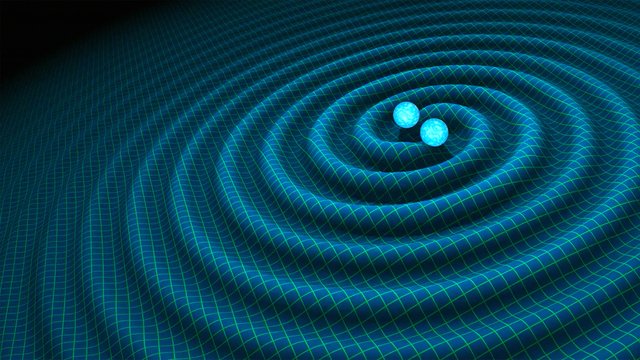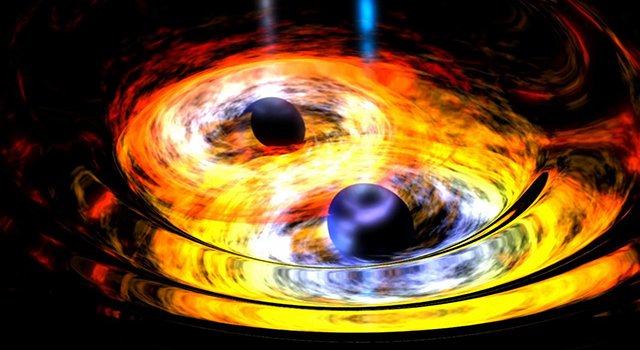Gravitational Waves
Space-time has weird properties, especially when black holes push it to the limit.

The SpaceTime Fabric
SpaceTIme can bend and warp. Anything with mass slows down time and bends the path of everything around it. This warping of space travels at the speed of light in all directions. This is called a gravitational wave and was originally predicted by Einstein's theory of relativity.
Black Holes
Black holes are points of infinite density where Spacetime is so warped that nothing can escape. This is a huge potential for gravitational waves, but they can’t do anything alone. Binary black holes are the most common sources of gravitational waves. The black holes in a binary system can orbit each other more than a thousand times a second. This orbiting causes a sudden change in the gravity of the system. When the black holes are orbiting fast enough this change in gravity can be detected. This usually happens when the black holes are close to colliding as they can often move at half the speed of light or more. All orbiting black holes will eventually collide (or be flung away), this is because gravitational waves actually carry energy. This energy being taken away by creating the gravitational waves causes the black holes to orbit closer together until they collide.
Even though stars and other object create gravitational waves, they are too weak for us to easily detect with this level of technology.
Detecting Gravitational Waves
Gravitational waves were detected using the LIGO interferometer (named after LIGO the Laser Interferometer Gravitational-Wave Observatory). The LIGO interferometer uses lasers to detect when space warps. The lasers are split into two parallel beams. These beams are bounced back in forth on mirrors. This is used to determine the distance between the two mirrors. Any temporary difference in the distance between the mirrors means that a gravitational wave passed through. These differences would be extremely small, less than 1 one thousandth the width of a proton.
Determining that a gravitational wave has passed through Earth is not enough. A goal of scientists is to find the source of the gravitational waves. The first step in this is to determine the direction of the wave. This requires multiple Ligo interferometers. Scientists use the times of detection for each of these LIGO interferometers to figure out the direction the wave was traveling and can use that to find the direction it came from. The next step is harder. They must figure out how powerful the wave is and then match it up with an object in space. Determining the power of the wave is simple, it just requires the amount the mirrors moved and a few calculations. Matching the wave up with an object in space requires a detailed map of that area in space. Space is really big, which has proven to be the biggest problem in determining the source of these waves.
The Two Detections of Gravitational Waves
Scientists have detected gravitational waves a total of two times.
The First Wave
The first wave, named GW150914, was discovered on September 14th, 2015. The black holes were about 29 and 36 times the mass of the sun. The gravitational waves released about 3 solar masses of energy in less than a second. (This is more than the output of the entire visible universe.) The detector in Livingston recorded the event 7 milliseconds before the detector in Hanford. This means that the waves came from somewhere in the southern hemisphere.
The Second wave
The second wave, named LVT151012, was found 16 days after the first. This was found in the data later with a 2% chance of being a false alarm. That is too high for anybody to claim that it is real with any certainty. There have been disturbances in the data before but they all have been a lot less than this.
The Third Wave
The third wave, named GW151226, was seen December 26th, 2015. This was from a collision between two smaller black holes of mass 14 and 8 times the sun. This wave hit both detectors at the same time. This makes it hard to determine the direction of the source. They were able to measure 27 total waves before they collided in under a second. They were also able to determine that one of the black holes was spinning rapidly.
Gravitational waves are launching physics into a new era. Sadly, we will need years, or even decades, to create instruments able to detect gravitational waves regularly.
here is a major peer-reviewed paper on the three gravitational waves.


They have anti-gravity craft flying our skies today. We live in an electric universe, and this tech will be in our hands this year.
what
There is no strong evidence for the electric universe paradigm. See, for instance, here where the EU theory has been proven wrong bit by bit.
Gravity is still a theory. Why is that?
Once again, a great post!
On the experimental side, Virgo is now ready, and Lisa will hopefully be there in the next decade to observe gravitational waves from space .
Note that there are actually three events, named GW150914, LVT151012 and GW151226 (yeah... I have to tag @justtryme90 for the names!), that were recorded. The second of these has a smaller significance but a huge Bayes factor associated with it.
rip I couldn't find a mention of the third one anywhere
In the publication: arXiv:1606.04856. Check tables 1 and 4.